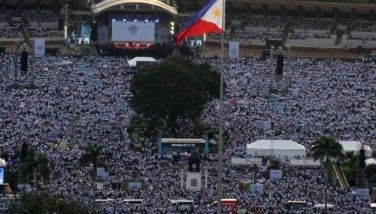Living with stagflation

It was just a year ago when we enjoyed the fastest economic expansion in decades and the lowest level of inflation in more than five years. Now, we find ourselves at a cusp of reversing fortunes.
At least that’s what the numbers are showing so far after the government announced last week that economic growth in the second quarter slowed to 4.6 percent, the lowest in three years and following a sharp revision of the first quarter expansion from 5.2 percent to just 4.7 percent.
Coming from its fastest growth in 31 years in 2007, the economy failed to sustain the momentum amid skyrocketing fuel and food prices that pushed inflation to a 17-year high in July.
Clearly, we have in our midst an animal that economists call stagflation – the unhappy union of slowing growth and accelerating inflation. If it’s any comfort, this predicament is neither new nor unique to the Philippines.
Many parts of the world are in a similar tight spot after crude oil prices soared to more than $100 per barrel and the home loan credit crisis hit the US a year ago that rocked its formerly revered banking foundations.
The Philippine economy, still largely dependent on the US economy, is a logical victim of imported stagflation. It does not help that the country imports almost all of its high-priced petroleum requirements.
Confounding remedies
And now that we’re officially suffering from this conflicted condition, the remedies are just more confounding. It’s like having diabetes and high blood pressure at the same time wherein what cures one, aggravates the other.
Take interest rates, for instance. Interest rates have gone up by a full percentage point since June and the central bank had so far raised borrowing cost to six percent to cool inflation.
By their nature, higher interest rates tend to choke the economy. BSP Governor Amando M. Tetangco Jr. has stated that the central bank would continue to focus on its mandate of price stability and prioritize it over the need to stoke the economy. In other words, he won’t hesitate to raise interest rates further to tame inflation, never mind the consequent lower growth.
For the central bank, keeping borrowing costs higher now will solve the country’s woes, including boosting a limping currency, and lead to a more sustained economic growth in the future. Whether this is the correct remedy for the situation we have today remains to be seen.
Changing lives
The slowing of the economic engines is already visibly affecting our daily lives.
More people are taking the public transport instead of driving their cars to work, thankfully easing traffic congestion in the metropolis.
Fewer people are dining out and the moneyed ones who used to frequent full service restaurants are eating more and more in the Jollibees of the world, while those who used to eat in fast foods now go to Jollyjeeps. Or for some, they suffer their hunger pangs till they reach home, hoping there’s still food in the house.
The changing spending pattern is seen in the many facets of consumption as everyday costs rise while incomes continue to be pegged at the pre-stagflation era. Daily wages, which are on the low side to begin with, rose by only five percent in the metropolis, less than half of the rate of inflation.
Yet raising wages higher than what employers can afford could only lead to job cuts and cause a price spiral that could give monetary authorities a harder time to arrest inflation.
Insufficient saving grace
At this point, monetary authorities are hoping that overseas workers’ remittances would again save the day for the economy.
Money sent home by overseas Filipino nurses and doctors, domestic helpers, IT experts and other workers rose 17 percent in the first half, with the June numbers alone jumping 30 percent from a year earlier.
This trend is giving some hope that by the second half, especially by the last quarter, the money being sent by our workers abroad would fuel spending and find its way into the economic engines.
There may be some cheer at the Noche Buena table courtesy of the overseas workers’ remittances, but these may not be enough to lift the country’s sodden economic spirit.
Collegiate Champions League update
PLDT, one of the giants in the local telecommunication industry, has joined SMART and Fil-Oil Flying V of the Villavicencio group of companies as major corporate supporters of the Philippine Collegiate Championship games. The financial backing extended by these corporate entities is a major boost to the promotion and development of collegiate basketball in the country.
The sponsorship of PLDT and SMART is the fulfillment of the commitment made by M. V. Pagilinan, Samahang Basketbol ng Pilipinas (SBP) president, to promote and institutionalize a genuine national collegiate basketball tournament that involves not only teams from the more popular leagues in Metro Manila but also teams from all localities where collegiate basketball leagues are organized.
The Philippine Collegiate Champions League (PCCL) is conducting this nationwide multi-level competition that starts with the “mother league” games and progresses to the regional and zonal championships and ends at the final phase, the “Sweet 16” Final Challenge in Manila. The Champions League’s objective is to provide teams and players the opportunity to look beyond their “mother leagues” and aim for higher achievements such as the regional and zonal championship and the chance to be crowned as the Philippine champion.
As part of their sponsorship support, SMART and PLDT will be conducting promotional activities to enliven the regional and zonal championships that will be held in various localities. FilOil Flying V of the Villavicencio group of companies, on the other hand, is the title sponsor of the “Sweet 16” Final Challenge and provides grants for scholarship and athletic facilities to the top four finalists.
To date, there are 212 teams from nine regional areas nationwide that are participating in the search for the best collegiate teams in the country. These teams are playing in 27 “mother leagues” that include the major leagues in Metro-Manila, the UAAP, NCAA, NAASCU, CUSA, and the CESAFI of Cebu City.
For more details about the biggest collegiate basketball event for the year sponsored by SMART and PLDT, visit the official website, www.CollegiateChampionsLeague.net
Should you wish to share any insights, write me at Link Edge, 25th Floor, 139 Corporate Center, Valero Street, Salcedo Village, 1227 Makati City. Or e-mail me at [email protected]. For a compilation of previous articles, visit www.BizlinksPhilippines.net.
- Latest
- Trending





























